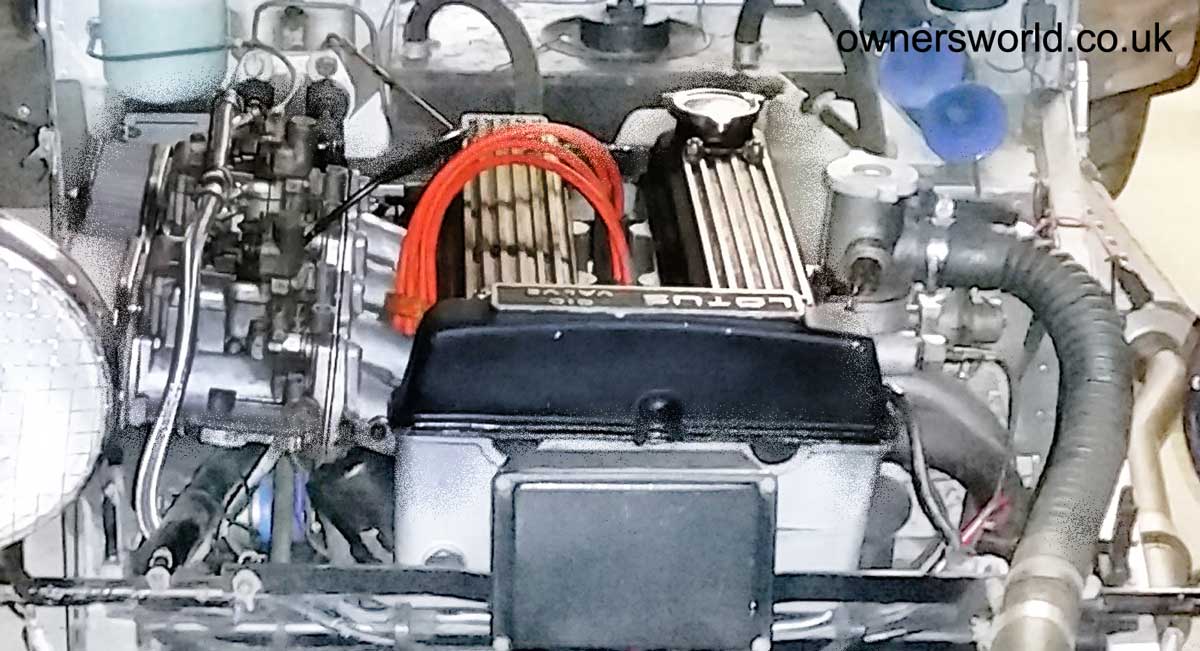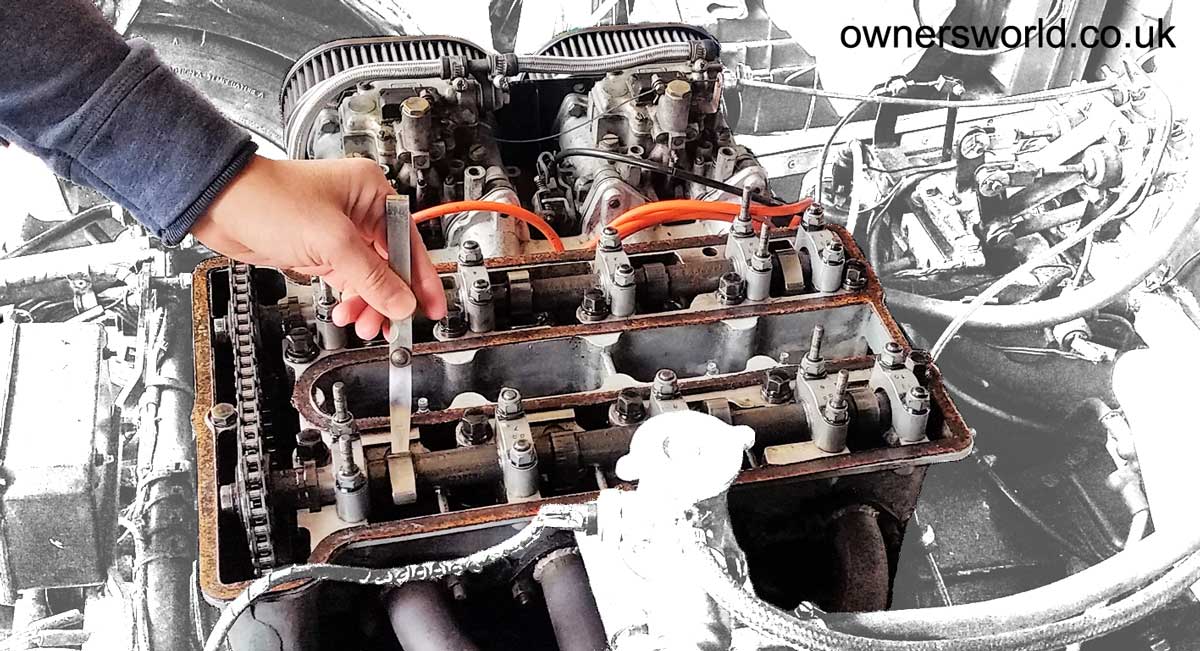
Back in May 2014, I took my Caterham Seven out for its first proper shakedown of the new season. I was making sure everything was working; not leaking, banging or smoking. All was fine until I got 200 meters from home when a disturbing and expensive sounding noise started emanating from the Lotus Twin Cam up front.
In this article, I’ll discuss Leak down testing; compression testing; vacuum testing; broken springs; valve clearances and big end problems.
This post contains affiliate links or sponsored content. See my Disclosure Policy for more details.
Once I had got my car was home, I asked my neighbour (who used to run a business preparing minis for racing back in the 80’s) to come and have a listen and give his opinion. I started the engine again, just briefly, to see if anything obvious could be identified. The noise sounded more top end than bottom end, it was a metallic tapping sound, in time with the engine revs but, other than that, we couldn’t say what the problem was.
Cost of repair
I enquired about having the engine rebuilt. The starting price was £2,400 to strip down, £2,400 to rebuild, plus the cost of fixing whatever might be found to be the problem … plus the dreaded VAT. I don’t have that sort of money to spend on what is effectively a hobby and I didn’t have time (or confidence) to rebuild the engine myself. I put the car in the garage and there it stayed until September 2016.

I needed to either fix the car or get rid of it. I knew that if the engine needed a rebuild, then I would need to do it myself because I couldn’t afford to have someone else do it for me. And I wouldn’t know what the scale of the rebuild was until I had diagnosed the problem.
I will go through the diagnosis in the order that I should have done it rather than the order that I actually did it!
My fear was that it was a big end / crankshaft problem, although I actually suspected it was a top end problem, so here is what I should have done …
disclaimer
The information contained herein is not meant to be comprehensive and is for information and entertainment purposes only.
You should not undertake to perform anything described herein without adequate training and/or supervision.
The author disclaims any responsibility for any injury, damage, or loss as a result of reliance upon the
information found on this site/blog.
Please see Terms for more details.
Leak down test
The Leak Down Test was something new to me and I have to say that it is a fantastic diagnostic tool. It can tell you where the pressure is leaking from within an engine cylinder and therefore where your issue is.
Read my How To: Leak Down Test for a detailed description of what is involved.
I connected the Leak Down Tester to both my air compressor and the spark plug hole of each cylinder in turn. I soon discovered the location of my Lotus Twin Cam’s problem when there was a whoosh of air out of the carburettor whilst testing cylinder number 2. This clearly indicated that the inlet valve on number 2 cylinder was not closing.
The readings from the other cylinders were good, with no evidence of any issues.
I was pretty sure that I had identified the problem, but whilst I was at it, I might as well continue through the other tests that I had lined up.
Compression test
If you don’t have a Leak Down Tester (and air compressor), I would definitely recommend getting a compression tester. A compression tester like mine, by Gunsons, is around £20 and is well worth having in the garage.
A compression test is simple to carry out and doesn’t require expensive equipment. It will quickly identify if you have a problem in the cylinder although it is not as specific as the leak down test as to what the problem is. Read my How To: Engine Compression Test for a detailed account of compression testing.
The basic process is to attach the compression tester to each cylinder in turn. Crank the engine over so that the compression in that cylinder is recorded on the gauge. Check that the pressure in each cylinder is in line with the specification in the owner’s manual. Also, check that readings for all cylinders do not differ by more than 10% when compared to one another.
Following the compression test on my engine, there was Zero compression on number 2 cylinder. The other 3 cylinders were fine with good compression and consistency between readings
Vacuum test
Just for completeness, you could carry out a vacuum test (I didn’t do this during my diagnosis and I don’t have an associated “How To” … yet!)
On the intake stroke, the piston acts as a suction pump to draw in the fuel/air mixture. This suction causes the pressure in the inlet manifold to drop as compared to atmospheric pressure. It is the amount and consistency of this pressure drop that you measure with your vacuum gauge.
The various readings can indicate leaking manifold or manifold gasket; worn rings; worn, burnt or sticking valves; leaking head gasket or problems with valve timing and ignition timing.
If you
my Facebook page, you will be automatically notified when I publish a new article.
Check for a broken valve spring
This test basically involves pushing down on the valve spring (I used a carefully calibrated, honkin’ great screwdriver to push down on the tappet). If the spring is broken or weak, you will be able to identify it by comparing with the other valve springs that you are testing. Make sure the that the valve is closed and that the piston is nearer the bottom of the cylinder than the top; if the spring is broken, you don’t want to push the valve into the piston crown. In my case, all of the springs appeared to be ok.
This is a simple test on an engine where each valve has a single spring. The Lotus Twin Cam (thanks Herb!) and my Frogeye’s A Series valves have double valve springs, one inside the other, so it is more difficult to assess accurately.
Valve Clearances
Adjusting the tappets on a Lotus Twin Cam is a far more involved job than on the A Series engine in my Frogeye Sprite. No simple release of a locknut; adjust the clearance and re-tighten the locknut. Nope … you need to take the camshafts out!
Measuring the clearance, however, is straightforward. The clearances on all of the valves except for one, were outside of tolerance and the culprit in number 2 cylinder was so far out that even when I added all of the blades on my feeler gauge together, they were still too small to measure the clearance. Confirmation, if any were now needed that the valve was jammed open.

Big end check
Here is a test if you suspect you have a dodgy big end. This is not foolproof by any means and is just a bit more information to build a picture of your potential problem.
Take the piston to Top Dead Centre and then continue turning the engine for about another 10 degrees so that the piston has just started its journey back down.
Next, find something that will fit in the spark plug hole that will take the strain of you pushing down sharply on it without breaking but won’t damage the piston crown. I used the handle of a long wooden spoon from the kitchen – my wife seemed less than impressed with my inventiveness!
Push down sharply on the piston. If you feel a click or movement, then you MAY have a big end bearing problem. I emphasise “may have” because as I said earlier, this is not a foolproof test. The movement could be the big end, the small end / gudgeon pin or movement in the piston rings. Either way, it is more “grist to the mill” as almost no-one ever says.
In my case, I felt the feintest of movement on number 1 piston. I am happy that it is not the cause of the problems for my engine but it will definitely need further investigation during a strip down and rebuild.
Engine noises
I am now confident that I know what the problem is; number 2 cylinder inlet valve jammed open. That could explain the tapping noise that accompanied it. Possibly the cam slapping the tappet or the piston hitting the valve (I hope not)
So, having identified the problem, I have decided to have a go at a full rebuild myself. I have rebuilt a number of A Series engines over the years but they are virtually bomb-proof in comparison to the Lotus Twin Cam.
Also, the rebuild will need to wait a little longer as my house is on the market and I don’t want to have the engine in pieces when we eventually sell and move.
Summary
You can use the above tests to identify, or at least, narrow down suspected issues with your engine. I particularly like the leak down test because of the clarity of information that it provides. A compression test every year will give you a good view of whether your engine is deteriorating over time.
If you know of any other tests that you think I should have carried out, please share it in the comments below.






